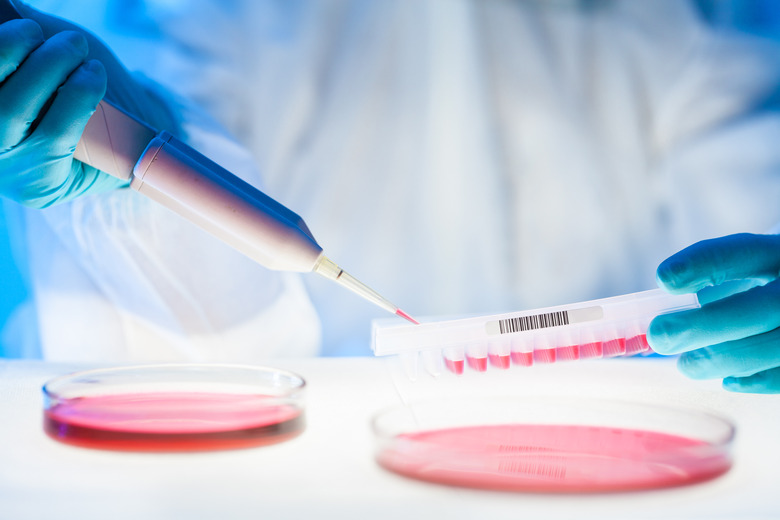When Do Chromosomes Duplicate During A Cell Life Cycle?
Within your body, cells continually reproduce to make new cells that will replace old ones. During this replication, a single cell splits in two, dividing in half the mother cell's contents, such as cytoplasm and the cell membrane, into two daughter cells. The dividing mother cell must also provide both daughter cells with a full set of chromosomes, not half a set. To do this, the mother cell must duplicate its chromosomes before cellular division. This duplication is done during the S phase of the cell cycle.
The Cell Cycle
The Cell Cycle
The cell cycle is the full life cycle of your body's cells and consists of two main phases: interphase and mitosis. Interphase is the G1, or gap 1, phase in which the new cell grows and carries out its functions in the body; the S, or synthesis, phase when the chromosomes replicate; and the G2, or gap 2, phase, when the cell grows further and prepares to divide. Then, during mitosis, the duplicated chromosomes line up and the cell splits into two daughter cells, each with a complete copy of the mother cell's full chromosome package.
S Phase Duplication
S Phase Duplication
During the S phase, DNA is synthesized to make two identical copies; each chromosome replicates to make a paired chromatid. These chromatids are joined by a protein link called a kinetochore which holds the pair together until mitosis. Once the chromosomes have replicated, the cell contains double the normal number chromosomes until the cell divides.
Method of Replication
Method of Replication
The full story of how the chromosomes replicate is complex, but a simplified way of thinking of this S phase replication is the unzipping of a strand of the two halves of DNA. The unzipped DNA half strand is then matched up with a newly formed half strand. Because both halves receive a new half strand, the cell ends up with a double set of chromosomes. The process of unzipping and forming a complementary half strand is completed by various enzymes and RNA molecules.
Interphase to Mitosis
Interphase to Mitosis
With its double pack of chromosomes, the cell continues to grow and function through the G2 phase. At the end of this phase, the cell forms structures called microtubules, which tug apart the chromatids by latching onto the kinetochore. Mitosis consists of four main events: prophase, metaphase, anaphase and telophase. During prophase, the nucleus of the mother cell breaks away, exposing the chromatids. In metaphase, the chromatids line up along the center of the cell and the microtubules attach to them. The microtubules then pull the chromatids apart in anaphase. During the final phase of mitosis, telophase, the cell pinches in two and each daughter cell forms a nucleus around its complete set of chromosomes. Mitosis only occurs in somatic cells — the cells that make up the body. Gametes — the egg or sperm cells that fuse with reproductive cells of the opposite sex — still replicate their chromosomes during the S phase, but undergo a double split in meiosis to end up with only half the chromosome package.
References
Cite This Article
MLA
Painter, Tammie. "When Do Chromosomes Duplicate During A Cell Life Cycle?" sciencing.com, https://www.sciencing.com/chromosomes-duplicate-during-cell-life-cycle-3261/. 13 March 2018.
APA
Painter, Tammie. (2018, March 13). When Do Chromosomes Duplicate During A Cell Life Cycle?. sciencing.com. Retrieved from https://www.sciencing.com/chromosomes-duplicate-during-cell-life-cycle-3261/
Chicago
Painter, Tammie. When Do Chromosomes Duplicate During A Cell Life Cycle? last modified March 24, 2022. https://www.sciencing.com/chromosomes-duplicate-during-cell-life-cycle-3261/
